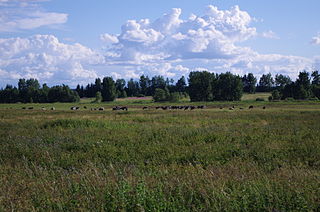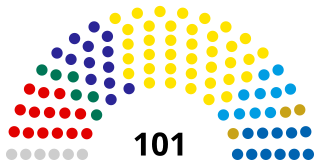| |||||
| Decades: | |||||
|---|---|---|---|---|---|
| See also: | |||||
This article lists events that occurred during 2006 in Estonia .
| |||||
| Decades: | |||||
|---|---|---|---|---|---|
| See also: | |||||
This article lists events that occurred during 2006 in Estonia .
The Republic of Estonia gained its independence from the Russian Empire on 24 February 1918 and established diplomatic relations with many countries via membership of the League of Nations. The forcible incorporation of Estonia into the Soviet Union in 1940 was not generally recognised by the international community and the Estonian diplomatic service continued to operate in some countries. Following the restoration of independence from the Soviet Union, Russia was one of the first nations to re-recognize Estonia's independence. Estonia's immediate priority after regaining its independence was the withdrawal of Russian forces from Estonian territory. In August 1994, this was completed. However, relations with Moscow have remained strained primarily because Russia decided not to ratify the border treaty it had signed with Estonia in 1999.

Latvia, officially the Republic of Latvia, is a country in the Baltic region of Northern Europe. It is one of the three Baltic states, along with Estonia to the north and Lithuania to the south. It borders Russia to the east, Belarus to the southeast, and shares a maritime border with Sweden to the west. Latvia covers an area of 64,589 km2 (24,938 sq mi), with a population of 1.9 million. The country has a temperate seasonal climate. Its capital and largest city is Riga. Latvians belong to the ethnolinguistic group of the Balts and speak Latvian, one of the only two surviving Baltic languages. Russians are the most prominent minority in the country, at almost a quarter of the population.

Tallinn is the capital and most populous city of Estonia. Situated on a bay in north Estonia, on the shore of the Gulf of Finland of the Baltic Sea, Tallinn has a population of about 454,000 and administratively lies in the Harju maakond (county). Tallinn is the main governmental, financial, industrial, and cultural centre of Estonia. It is located 187 km (116 mi) northwest of the country's second largest city, Tartu; however, only 80 km (50 mi) south of Helsinki, Finland, also 320 km (200 mi) west of Saint Petersburg, Russia, 300 km (190 mi) north of Riga, Latvia, and 380 km (240 mi) east of Stockholm, Sweden. From the 13th century until the first half of the 20th century, Tallinn was known in most of the world by variants of its other historical name Reval.

The Baltic states or the Baltic countries is a geopolitical term encompassing Estonia, Latvia, and Lithuania. All three countries are members of NATO, the European Union, the Eurozone, and the OECD. The three sovereign states on the eastern coast of the Baltic Sea are sometimes referred to as the "Baltic nations", less often and in historical circumstances also as the "Baltic republics", the "Baltic lands", or simply the Baltics.

Tartu County is one of 15 counties of Estonia.

The Lithuania national football team represents Lithuania in men's international football, and is controlled by the Lithuanian Football Federation, the governing body for football in Lithuania. They played their first match in 1923. In 1940, Lithuania was occupied by the Soviet Union; the country regained its independence in 1990 and played their first match thereafter against Georgia on 27 May of that year.

The Riigikogu is the unicameral parliament of Estonia. In addition to approving legislation, the Parliament appoints high officials, including the prime minister and chief justice of the Supreme Court, and elects the president. Among its other tasks, the Riigikogu also ratifies significant foreign treaties that impose military and proprietary obligations and bring about changes in law, as well as approves the budget presented by the government as law, and monitors the executive power.

Ruhnu is an Estonian island in the Gulf of Riga in the Baltic Sea. Its territory of 11.9 square kilometres (4.6 sq mi) is administratively part of Saare maakond (county). Ruhnu lies geographically closer to the coast of Courland on the mainland of Latvia than it is to any point in rest of Estonia. With less than 150 official residents, the Ruhnu vald (parish) has the smallest population of Estonia's 79 municipalities. Before 1944, it was for centuries populated by ethnic Swedes and traditional Swedish law was used.
The Pro Patria Union was a national-conservative political party in Estonia. The party was founded on 2 December 1995 from a merger of the Estonian National Independence Party and the Pro Patria National Coalition.

The Battle of Narva was a World War II military campaign, lasting from 2 February to 10 August 1944, in which the German Army Detachment "Narwa" and the Soviet Leningrad Front fought for possession of the strategically important Narva Isthmus.
Television in Estonia was introduced in 1955, following the Soviet government's decision to establish a television station in 1953. The National TV Channel ETV has maintained an archive since 1955 in which broadcasts of unique aspects of Estonian culture are held.

The Estonian Navy are the unified naval forces among the Estonian Defence Forces.

The history of Jews in Estonia starts with reports of the presence of individual Jews in what is now Estonia from as early as the 14th century.
Constitution of Estonia is the fundamental law of the Republic of Estonia and establishes the state order as that of a democratic republic where the supreme power is vested in its citizens. The first Constitution was adopted by the freely elected Estonian Constituent Assembly on 15 June 1920 and came into force on 21 December 1920. Heavily amended on 24 January 1934, following a referendum in 1933, it was in force until the second Constitution was enacted on 1 January 1938. It remained in force, de facto, until 16 June 1940, when the Soviet Union occupied Estonia and, de jure, until 28 June 1992, when the third and current Constitution of the Republic of Estonia was adopted by referendum.

The Turkey women's national football team represents Turkey in international women's football. The team was established in 1995, and compete in the qualification for UEFA Women's Championship and the UEFA qualifying of FIFA Women's World Cup. It has been recognized as Türkiye by the FIFA and UEFA since 2022.

The Estonian Border Guard was the national security agency responsible for the border security of Estonia. It was subordinate to the Ministry of the Interior. The Border Guard also assisted with Search and Rescue missions. In 2010, the organization was superseded by the Police and Border Guard Board.

Estonia–India relations refers to the bilateral diplomatic relations between Estonia and India. India first recognised Estonia on 22 September 1921 when the former had just acquired membership in the League of Nations. India re-recognised Estonia on 9 September 1991 and diplomatic relations were established on 2 December of the same year in Helsinki. Estonia is represented in India by its embassy in New Delhi and its honorary consulate in Mumbai. India is represented in Estonia through its embassy in Helsinki (Finland) and through an honorary consulate in Tallinn.

Väätsa is a small borough in Järva County, in central Estonia. It's located about 6 km (4 mi) west of the town of Paide, and about 9 km (6 mi) north of Türi. Väätsa was the administrative centre of Väätsa Parish, and is now part of Türi Parish. Väätsa has a population of 704.

Estonia, officially the Republic of Estonia, is a country by the Baltic Sea in Europe. It is bordered to the north by the Gulf of Finland across from Finland, to the west by the sea across from Sweden, to the south by Latvia, and to the east by Lake Peipus and Russia. The territory of Estonia consists of the mainland, the larger islands of Saaremaa and Hiiumaa, and over 2,200 other islands and islets on the eastern coast of the Baltic Sea, covering a total area of 45,339 square kilometres (17,505 sq mi). The capital city Tallinn and Tartu are the two largest urban areas of the country. The Estonian language is the indigenous and the official language of Estonia; it is the first language of the majority of its population, as well as the world's second-most spoken Finnic language.

VKG Elektrivõrgud is an electricity distribution company in Estonia. It is a subsidiary of Viru Keemia Grupp. VKG Elektrivõrgud is the second-largest power distribution company in Estonia, after Eesti Energia Jaotusvõrk.